10 Under 10: Deaf dentist builds bridge between communities

2024 10 Under 10 Award winner Joseph Samona, D.M.D., is building a bridge between the Deaf community and dentistry.
Born with profound bilateral sensorineural hearing loss, Dr. Samona faced a winding road to becoming a licensed, practicing dentist, but it’s a journey that is now creating a positive impact in the profession and within the Deaf community.
Growing up, his interests were aligned with dentistry. He loved science, medicine, engineering and art, and he was passionate about helping people.
“For me, dentistry is a mix of engineering, science and art,” Dr. Samona said.
He didn’t become more fluent in American Sign Language until high school, so he relied heavily on lip reading.
“Growing up, the first thing I see on a person is their smile. A person’s smile is a form of communication because I lip read,” he said. “If people are insecure about their smile, they tend to cover their mouth, and then it’s harder for me to understand what they’re saying and communicate.”
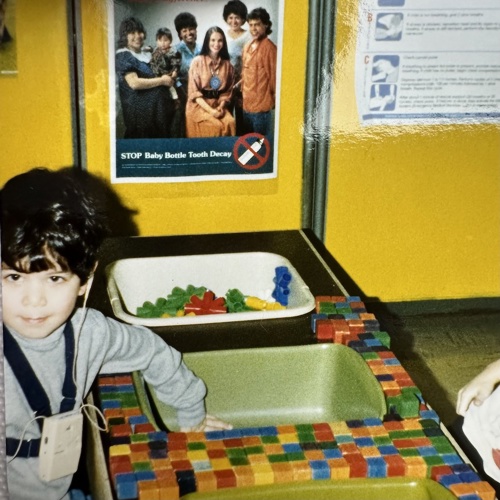
It only took one visit to the dentist during high school for Dr. Samona to know dentistry was the profession for him, even if it would be a long road full of opportunities and challenges.
Becoming a dentist requires lengthy schooling. As a deaf student, Dr. Samona had a difficult time learning in middle school and high school because he didn’t have an ASL interpreter in classes with him. He relied on lip reading, textbooks and notes to help provide him with a more complete classroom experience.
It wasn’t until he enrolled in the University of Detroit Mercy for undergrad that an ASL interpreter was provided for him, which made learning so much easier.
“That was a new experience for me in undergrad, and I’m grateful to have that,” Dr. Samona said.
Around the same time, he started learning more ASL and became more involved in the Michigan Deaf community. One of his older sisters, who is also deaf, helped him embrace that part of himself, build more confidence and find connection. Finding this connection presented him with an opportunity to make an impact around oral health.
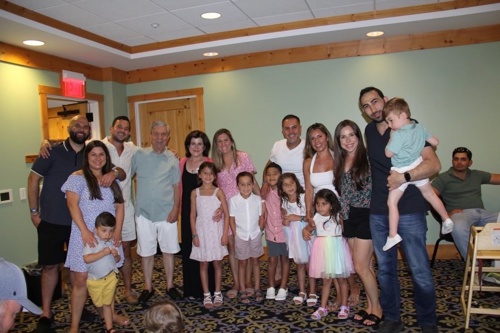
“Research has shown that deaf people have a higher prevalence of getting cavities compared to hearing people. That’s because of the language barrier,” Dr. Samona said. “Deaf people’s primary language is sign language; English is often their second language. ASL and English have very different grammatical word order, so sometimes reading in English can be harder for the deaf patient to follow along. Deaf people actually have a lower reading literacy, so they benefit more from having education with an interpreter or having content in sign language.”
During undergrad at Detroit Mercy, Dr. Samona was the only deaf student, so he had to become a teacher himself. He had to educate his interpreter and teachers about how to work with him and communicate during labs and times when professors spoke at the same time as demonstrating.
“There was a big learning curve for me, the interpreter and the teachers,” he said. “I never had one bad interaction with any of the teachers. They were very understanding.”
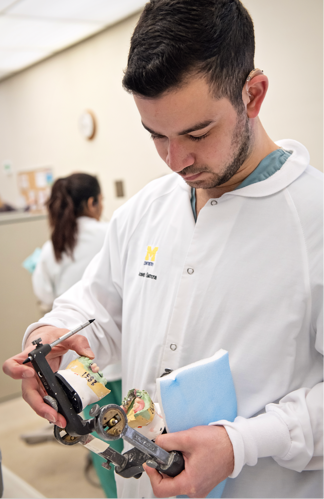
As undergrad wrapped up and he looked toward dental school, Dr. Samona prioritized dental school programs in the Michigan area to stay close to family. He also knew he would likely again be the only deaf student attending at that time. When he enrolled in the University of Michigan School of Dentistry, the school had only one other deaf student in its history, and that was 30 years ago.
During his dental school orientation period, Dr. Samona could tell immediately that some of his fellow students didn’t know he was deaf, so he created a video introducing himself and the best ways to communicate with him and sent it to all of his classmates. That created opportunities for connection with his fellow students.
“When my classmates reached out to me with questions and wanted to learn more about the Deaf culture, I felt more welcome by the community and by my classmates because they truly cared about making everyone feel included,” he said. “I have a lot of great friends from dental school, and those were the best four years of my life because of that support from my classmates and faculty at U of M dental school.”
The dental school faculty were very accommodating on adapting and learning how to work with him and his interpreter. Dr. Samona could even tell them how he preferred to learn in classroom and lab settings.
“There are actually no dental words in sign language, so I ended up making my own sign language terminology and I made it more clear for myself and the interpreter,” he said.

This sparked an idea that made him the unknowing spokesperson for oral health in the Deaf community and an important representation of opportunities for that community in the health care field.
Working with his mentor, Dr. Samona created a research project that included a video in ASL about oral health education, including his journey to dental school, cavities, gum disease, nutrition, diet and oral hygiene. The 30-minute video also aimed to inspire deaf youth to look at a career in health care and dentistry.
Once complete, the final video was posted on YouTube and shared at the Michigan School for the Deaf and other deaf schools nationwide.
“I didn’t think the video I had would blow up and be beneficial to deaf schools in the nation, but a lot of people watched it and want me to create more videos, so I’m looking to create a few more in the future,” Dr. Samona said.
He also got real-time feedback from other deaf people in the YouTube comments. They commented that the video was educational and impactful, it made a difference for them and it was nice to learn more about oral health through sign language.
That feedback, along with the positive response to his introduction video from the other University of Michigan dental students, inspired him to create a more robust plan for the university about how to interact with, communicate with and teach deaf students.
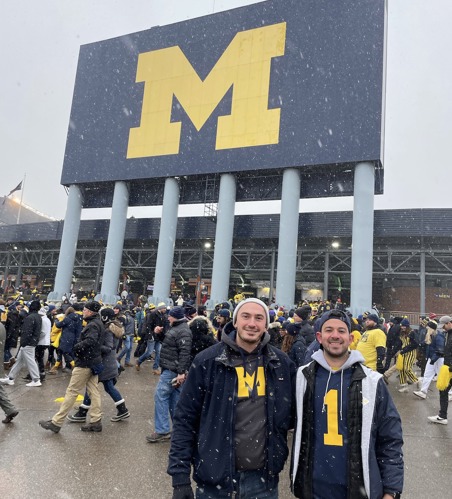
When Dr. Samona was in his fourth year of dental school, another deaf student enrolled, and the two formed a bond from their unique experiences. Dr. Samona was also able to share what he had learned with the new student to help him navigate the years ahead.
In response to his popular YouTube video, other deaf dental students around the country reached out to him on Instagram, which created a little community of people who understood the challenges they face working in this field.
“I was very happy to hear that from them because it builds a sense of community,” Dr. Samona said. “If we keep supporting each other, we can grow the number of deaf dentists in the nation and make a difference in our profession.”
With dental school wrapping up, Dr. Samona started to think about his goals in dentistry and what he wanted his career in it to look like.
“My main goal was to eventually open a practice while also making a difference in my Deaf community and driving change in organized dentistry to support and encourage deaf people,” he said.
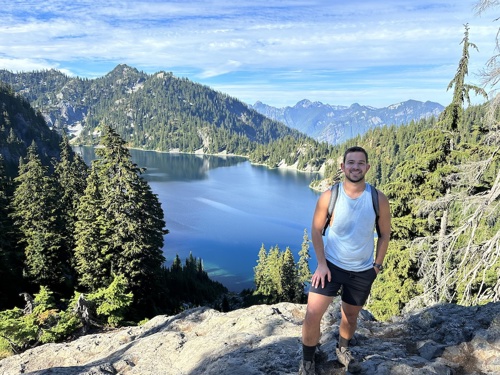
Before he could start making that dream a reality, he enrolled in an Advanced Education in General Dentistry one-year residency program at the University of Texas at San Antonio to keep building a robust knowledge base of the profession to benefit his future patients — both hearing and deaf.
The program meant relocating from his tight-knit community in Michigan.
“My parents were nervous about me moving to Texas,” Dr. Samona said. “I know they were nervous because they love me, so I kept reminding them that the residency program was strong and would be beneficial to my career long term. When I first moved away, I didn’t know anyone in Texas, but after a few months, I was making friends with my co-residents and we still see each other once a year.”
Three months after graduating from the program, Dr. Samona moved back to his home base in Michigan and started working part time in private practice to build up his patient base.
Now a full-time dentist in private practice, he sees a mix of hearing and deaf patients. Some of those deaf patients drive more than an hour to see him.
“It’s extremely rewarding for me to be working as a deaf dentist and have deaf patients,” Dr. Samona said. “Those patients share their experience with hearing dentists, which wasn’t always positive, or the dentist wasn’t able to accommodate them in the office. Because I know what it’s like to be deaf and in the dentist chair, being with me made them feel less anxious and they felt more comfortable and they could trust someone.”
Dr. Samona does not have an interpreter at the private practice, so when he treats hearing patients, it’s a team effort between him and the dental hygienists. The hygienists tell patients that Dr. Samona is deaf and they need to look at him so he can read lips. When there is a communication gap with hearing patients, the hygienists help bridge it.
“They’re basically my right-hand person; I rely on them for a lot of things,” he said.
Some of the hygienists are even taking ASL classes to help make communication more seamless when they see patients.
“Learning that the hygienists are taking ASL classes made me feel welcome because they truly care and want to learn the language to communicate with me better,” Dr. Samona said. “I was touched to know they would go out of their way to take classes.”
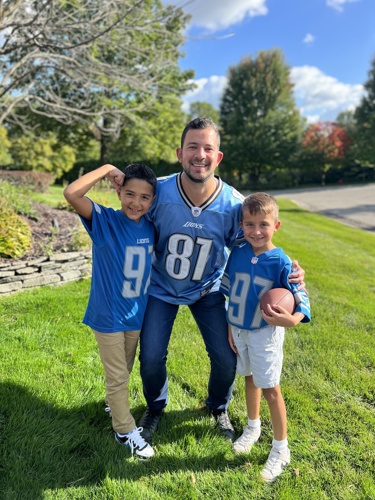
Dr. Samona has traveled a long and challenging road to get to this point, and he hopes the impact he will make for other deaf dental students and deaf people interested in health professions is vast.
In July, he started a periodontist residency that will keep him busy for the next three years and get him one step closer to his goal of owning a practice and creating an inclusive oral health environment for all deaf people.
Outside of the clinic, Dr. Samona is very close with his family, including his four sisters and 11 nieces and nephews. He is also active in sports, traveling and hiking.
To him, being recognized as one of the ADA’s 10 Under 10 Award winners means increasing awareness of being deaf and working in dentistry, an opportunity he’s so grateful for and knows will have a lasting impact.
“Deaf people can do anything; the only thing they can’t do is hear,” Dr. Samona said.
Learn more about the 10 Under 10 Awards program at ADA.org/10Under10 and get inspired at SmileCon's Changemakers Celebration, which will recognize this year’s 10 Under 10 Award winners and other award recipients.



